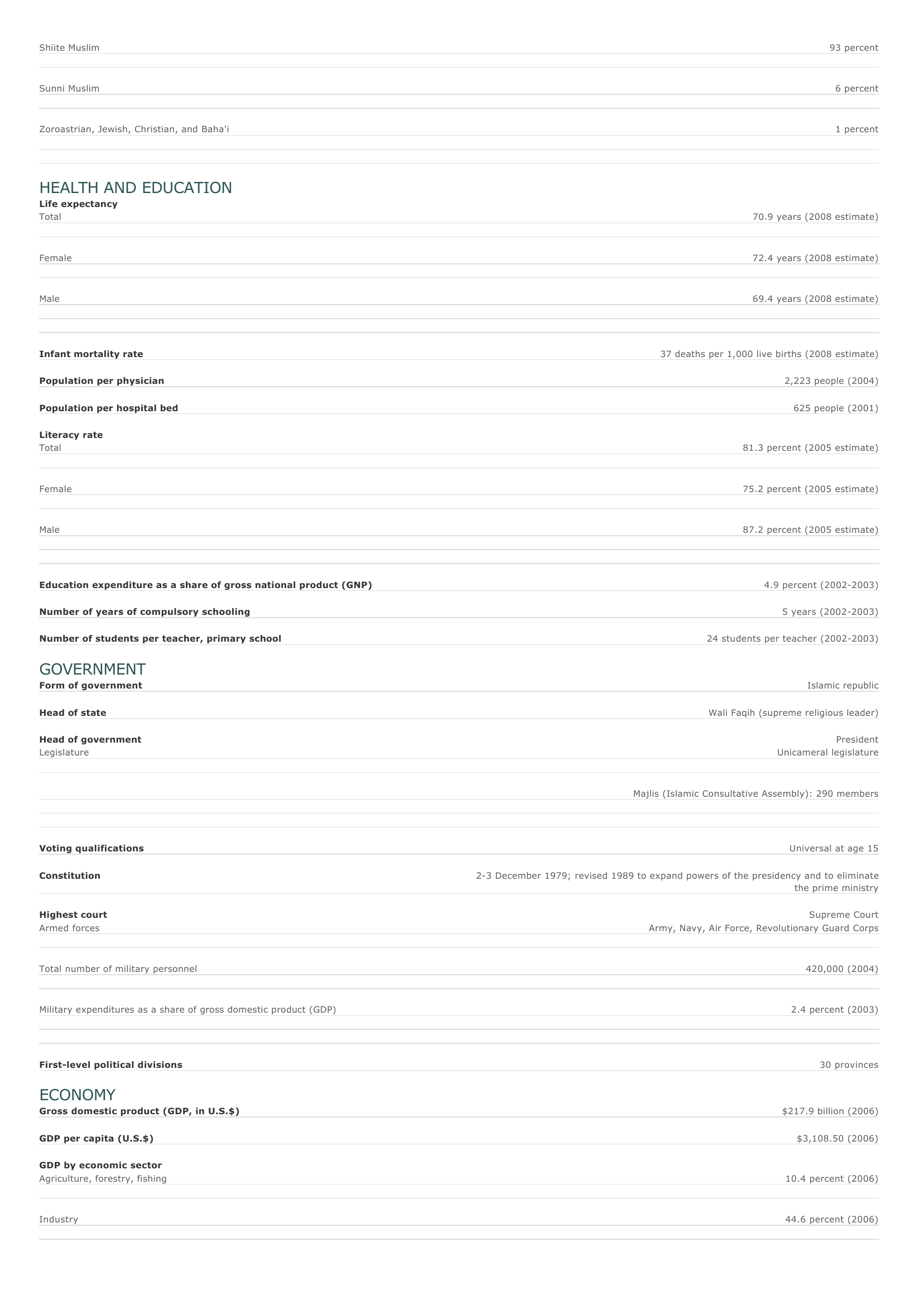
Iran Facts and Figures. BASIC FACTS Official name Capital Area Islamic Republic of Iran Tehr? n 1,648,000 sq km 636,300 sq mi PEOPLE Population 65,875,223 (2008 estimate) Population growth Population growth rate 0.79 percent (2008 estimate) Projected population in 2025 76,779,032 (2025 estimate) Projected population in 2050 81,490,039 (2050 estimate) Population density 40 persons per sq km (2008 estimate) 104 persons per sq mi (2008 estimate) Urban/rural distribution Share urban 68 percent (2005 estimate) Share rural 32 percent (2005 estimate) Largest cities, with population Tehr? n 6,758,845 (2006) Mashhad 2,926,000 (2007 estimate) E? fah ?n 1,001,000 (2007 estimate) S h ?r ?z Karaj 1,263,244 (2006) 941,000 (2007 estimate) Ethnic groups Persian 60 percent Azerbaijani and other Turkic 25 percent Kurdish 7 percent Lur 2 percent Baluch, Turkmen, and other 6 percent Languages Persian (Farsi) and Persian dialects 58 percent Turkic and Turkic dialects 26 percent Kurdish 9 percent Luri, Baluchi, Arabic, Turkmen, and other 7 percent Religious affiliations Shiite Muslim 93 percent Sunni Muslim 6 percent Zoroastrian, Jewish, Christian, and Baha'i 1 percent HEALTH AND EDUCATION Life expectancy Total 70.9 years (2008 estimate) Female 72.4 years (2008 estimate) Male 69.4 years (2008 estimate) Infant mortality rate Population per physician Population per hospital bed 37 deaths per 1,000 live births (2008 estimate) 2,223 people (2004) 625 people (2001) Literacy rate Total 81.3 percent (2005 estimate) Female 75.2 percent (2005 estimate) Male 87.2 percent (2005 estimate) Education expenditure as a share of gross national product (GNP) Number of years of compulsory schooling Number of students per teacher, primary school 4.9 percent (2002-2003) 5 years (2002-2003) 24 students per teacher (2002-2003) GOVERNMENT Form of government Head of state Head of government Legislature Islamic republic Wali Faqih (supreme religious leader) President Unicameral legislature Majlis (Islamic Consultative Assembly): 290 members Voting qualifications Constitution Highest court Armed forces Total number of military personnel Military expenditures as a share of gross domestic product (GDP) First-level political divisions Universal at age 15 2-3 December 1979; revised 1989 to expand powers of the presidency and to eliminate the prime ministry Supreme Court Army, Navy, Air Force, Revolutionary Guard Corps 420,000 (2004) 2.4 percent (2003) 30 provinces ECONOMY Gross domestic product (GDP, in U.S.$) GDP per capita (U.S.$) $217.9 billion (2006) $3,108.50 (2006) GDP by economic sector Agriculture, forestry, fishing 10.4 percent (2006) I ndustry 44.6 percent (2006) Services Employment Number of workers 45 percent (2006) 29,064,702 (2006) Workforce share of economic sector Agriculture, forestry, fishing 25 percent (2005) I ndustry 30 percent (2005) Services 45 percent (2005) Unemployment rate 11.6 percent (2003) National budget (U.S.$) Total revenue $78,852 million (2006) Total expenditure $54,018 million (2006) Monetary unit 1 Iranian rial (IR), consisting of 100 dinars Agriculture Wheat, barley, potatoes, rice, grapes, fresh and dried fruit, sugar beets, sugarcane, vegetables, pulses, maize, tea, tobacco, oilseeds, pistachio nuts, mutton and poultry Mining Petroleum, natural gas, coal, iron ore, chromite, lead, zinc, copper, manganese Manufacturing Textiles, food products, construction material, nonelectrical machinery, iron and steel, petrochemicals Major exports Crude petroleum and petroleum products, carpets, fruits, nuts, animal hides Major imports Machinery, iron and steel, foodstuffs, pharmaceuticals, refined petroleum products Major trade partners for exports Japan, China, Italy, South Korea, and Greece Major trade partners for imports Germany, United Arab Emirates, Italy, Russia, and France ENERGY, COMMUNICATIONS, AND TRANSPORTATION Electricity production Electricity from thermal sources Electricity from hydroelectric sources 92.97 percent (2003 estimate) 7.03 percent (2003 estimate) Electricity from nuclear sources 0 percent (2003 estimate) Electricity from geothermal, solar, and wind sources 0 percent (2003 estimate) Number of radios per 1,000 people 252 (1998 estimate) Number of telephones per 1,000 people 278 (2005) Number of televisions per 1,000 people 158 (2000 estimate) Number of Internet hosts per 10,000 people 0.76 (2003) Daily newspaper circulation per 1,000 people 24 (1996) Number of motor vehicles per 1,000 people 41 (1997) Paved road as a share of total roads 67 percent (2003) SOURCES Basic Facts and People sections Area data are from the statistical bureaus of individual countries. Population, population growth rate, and population projections are from the United States Census Bureau, International Programs Center, International Data Base (IDB) (www.census.gov). Urban and rural population data are from the Food and Agriculture Organization (FAO) of the United Nations (UN), FAOSTAT database (www.fao.org). Largest cities population data and political divisions data are from the statistical bureaus of individual countries. Ethnic divisions and religion data are largely from the latest Central Intelligence Agency (CIA) World Factbook and from various country censuses and reports. Language data are largely from the Ethnologue, Languages of the World, Summer Institute of Linguistics International (www.sil.org). Health and Education section Life expectancy and infant mortality data are from the United States Census Bureau, International Programs Center, International database (IDB) (www.census.gov). Population per physician and population per hospital bed data are from the World Health Organization (WHO) (www.who.int). Education data are from the United Nations Educational, Scientific and Cultural Organization (UNESCO) database (www.unesco.org). Government section Government, independence, legislature, constitution, highest court, and voting qualifications data are largely from various government Web sites, the latest Europa World Yearbook, and the latest Central Intelligence Agency (CIA) World Factbook. The armed forces data is from Military Balance. Economy section Gross domestic product (GDP), GDP per capita, GDP by economic sectors, employment, and national budget data are from the World Bank database (www.worldbank.org). Monetary unit, agriculture, mining, manufacturing, exports, imports, and major trade partner information is from the statistical bureaus of individual countries, latest Europa World Yearbook, and various United Nations and International Monetary Fund (IMF) publications. Energy, Communication, and Transportation section Electricity information is from the Energy Information Administration (EIA) database (www.eia.doe.gov). Radio, telephone, television, and newspaper information is from the United Nations Educational, Scientific and Cultural Organization (UNESCO) database (www.unesco.org). Internet hosts, motor vehicles, and road data are from the World Bank database (www.worldbank.org). Note Figures may not total 100 percent due to rounding. Microsoft ® Encarta ® 2009. © 1993-2008 Microsoft Corporation. All rights reserved.





